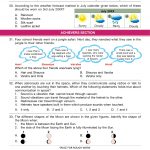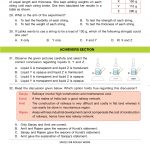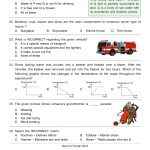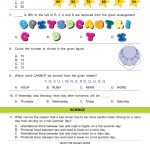Grade 3 NSO papers
Tag Archives: free nso papers for grade 3
Grade 3 Science (NSO) : Earth and Universe
A look at the previous lessons on earth and universe :
Grade 2 Science (NSO) : Earth and universe
Weather and The Sky: Earth and Sky fundamentals
Earth’s Revolution
The motion around the sun along its orbit is called a revolution . The amount of time it takes for a single trip around the sun is called a period of revolution. The period for the Earth to revolve around the sun is 365.24 days or one year. The .24 days is why every four years February has 29 days.
There are 4 seasons in an year .In Autumn and Spring the northern and southern hemispheres are tilted equally toward the sun.In Summer the Earth is on the other side of the sun and the northern hemisphere is tilted toward the sun and gets better sun rays. In winter the northern hemisphere is tilted away from the sun. That’s how we get seasons.
Earth’s orbit around the sun is slightly elliptical, Earth is actually slightly closer to the sun in the winter than it is in the summer.It is the tilt of Earth’s axis that causes the seasons.
Grade 3 Science(NSO) : Human body part 2
We have already covered Skeletal, immune, cardiovascular, muscular and integumentary system in part 1.
Grade 3 Science (NSO) : Human body part 1
Lymphatic system :
It is responsible for the removal of interstitial fluid from tissues. It absorbs and transports fatty acids and fats as chyle from the digestive system. It transports white blood cells to and from the lymph nodes into the bones.
-picks up fluids leaked from the capillaries
-supports immune systems: houses white blood cells Continue reading
Grade 3 Science (NSO) : Food part 3 – Preservation of food
Food Decay and Preservation
Bacteria and fungi are the main groups of decomposer organisms. Food decay is also known as food spoilage.
Bacteria and fungi need Food , Warmth and Moisture to grow.
There are several ways to stop or slow down the decay of foods. This is known as Food Preservation.
Food preservation methods
Freezing
Bacteria cannot reproduce at low temperatures.
Bacteria and fungi need warmth to grow. In low temperatures they stop growing.
Following is the list of food preserved by freezing;
- Meat
- Fish
- Fruits
- Vegetables
- Fresh foods
- Cooked foods
Drying
Removing water prevents the microorganisms from growing, or digesting the food.
Grade 3 Science (NSO) : Food Part 1 – Food Types
A look at the grade 2 lesson
Food can be divided into three types
Energy giving food
Give us energy to work. They contain carbohydrate and fats.
Carbohydrates
They are found in foods like rice, pasta, cassava, yam etc. when starchy foods are eaten and digested, simple sugars like glucose are obtained. It is this glucose that the body uses for energy.
There are two major types of carbohydrates:
1. Simple carbohydrates (Sugar)
- Fruits
- Milk
- White sugar you would find in a sugar bowl
- Chocolates
Grade 3 Science (NSO) : Birds
Bird, a warm-blooded vertebrate that lays eggs and has feathers and wings.
Type of beaks
Grade 3 Science (NSO) : Flower, fruit and seed
Before starting lets take a look at the Grade 2 lessons
Plants : Uses of different plants
Flower
Responsible for reproduction
Colour and fragarence of flowers attract insects who act as pollinators.
Flower parts that we eat :
Grade 3 Science(NSO) : Leaf
Functions of a leaf
Absorbs sunlight
Help in exchange of gases
Carries out photosynthesis
Apex : Tip of leaf
Base : Attaches to petiole ; if petiole is absent attaches directly to stem
Margin : Edge of leaf
Grade3 Science (NSO) : Plants :Roots
Plants :Roots
Root
Root is the underground part of the plants body. It fixes the plant within the soil and absorbs water and mineral nutrients from the soil. It also stores excess food.
Function of roots
- Roots attach the plant body to the ground. It provides support to the plant and helps in holding the plant firmly in the ground.
- Root hairs of the plant absorb water and mineral from the soil and pass it to the stem.
- Some roots like carrot, radish etc. store food.
- Root bind the soil which otherwise may be blown away by wind or washed away by water. Root prevents soil erosion.











